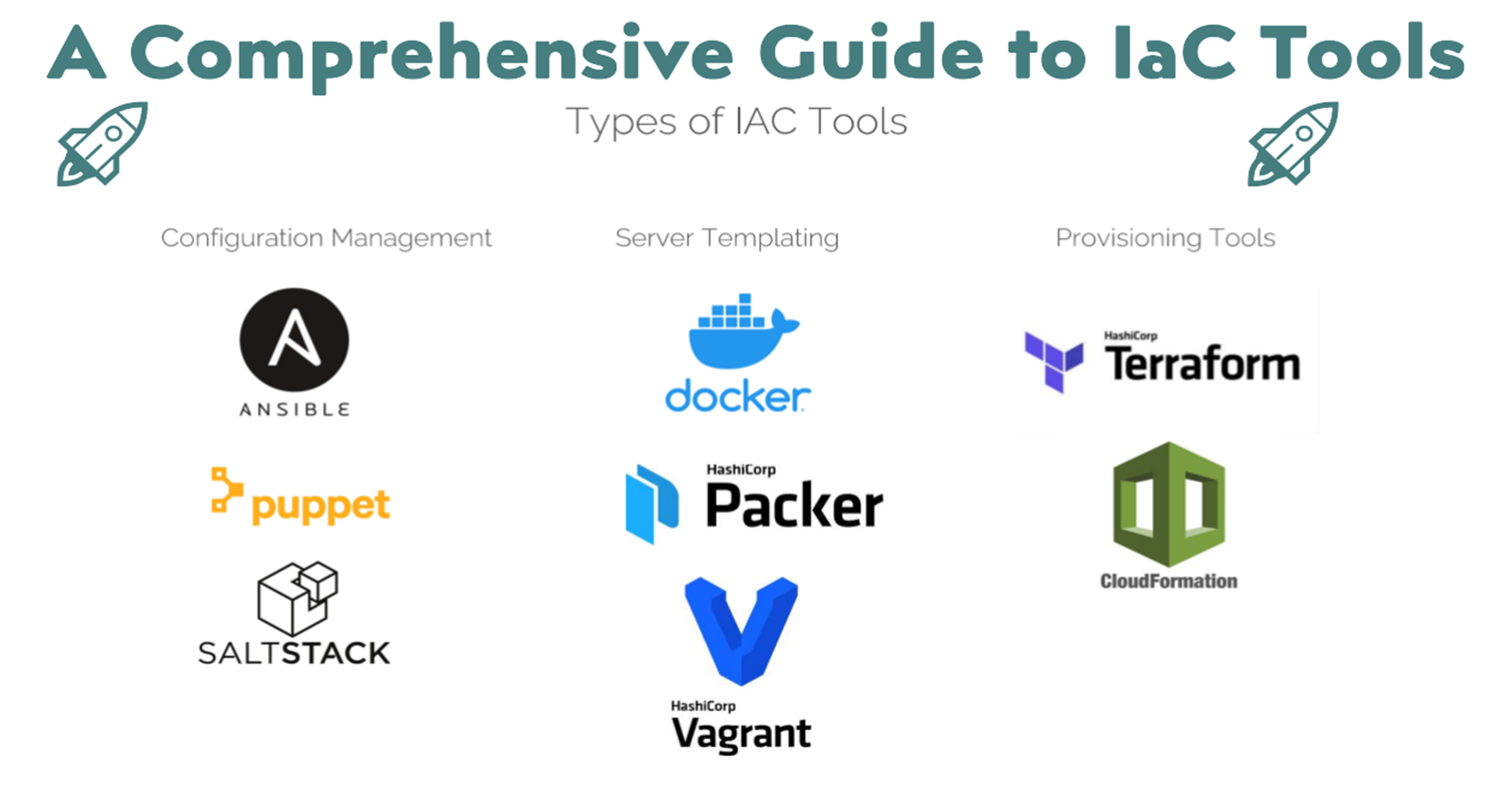Infrastructure as Code (IaC): A Comprehensive Guide to IaC Tools 🚀
 Sprasad Pujari
Sprasad Pujari
Infrastructure as Code (IaC) has revolutionized the way we manage and deploy IT infrastructure. In this comprehensive guide, we'll explore the different types of IaC tools, their use cases, and how they fit together in a modern DevOps environment.
Types of IaC Tools 🛠️
IaC tools can be broadly categorized into three main types:
Configuration Management Tools
Server Templating Tools
Provisioning Tools
Let's dive deep into each category and understand their roles with real-world examples.
1. Configuration Management Tools 🔧
Configuration management tools are designed to install and manage software on existing servers. They maintain a standard structure, provide version control, and ensure idempotency (the ability to run the same configuration multiple times without changing the result).
Key players:
Ansible
Puppet
SaltStack
Features:
📦 Designed to install and manage software
🏗️ Maintains standard structure
🔄 Version control
🔁 Idempotent
Real-world example: Imagine a large e-commerce company with hundreds of web servers. Using Ansible, they can:
🔄 Update the web server configuration across all machines simultaneously
🔒 Apply security patches to all servers with a single command
📊 Ensure all servers have the same monitoring agent installed and configured
# Ansible playbook example
- name: Ensure web servers are configured correctly
hosts: web_servers
tasks:
- name: Install Nginx
apt:
name: nginx
state: present
- name: Copy Nginx configuration file
template:
src: nginx.conf.j2
dest: /etc/nginx/nginx.conf
- name: Ensure Nginx is running
service:
name: nginx
state: started
enabled: yes
2. Server Templating Tools 📦
Server templating tools are used to create pre-configured machine images with installed and configured software. These images can be used to create new servers quickly.
Key players:
Docker
Packer
Vagrant
Features:
💾 Pre-installed software and dependencies
🖥️ Create virtual machine or Docker images
🔒 Support for immutable infrastructure
Real-world example: A software development team uses Docker to containerize their microservices application:
# Dockerfile example
FROM node:14
WORKDIR /app
COPY package*.json ./
RUN npm install
COPY . .
EXPOSE 3000
CMD ["npm", "start"]
With this Dockerfile, they can:
🚀 Ensure consistent environments across development, testing, and production
🔄 Easily update and roll back versions of their services
🔧 Quickly spin up new instances of their application for scaling
3. Provisioning Tools ☁️
Provisioning tools are used to create the infrastructure itself, including servers, databases, network components, etc. They work with multiple cloud providers and can manage complex infrastructure setups.
Key players:
Terraform
CloudFormation
Features:
🏗️ Deploy immutable infrastructure resources
💻 Manage servers, databases, network components, etc.
☁️ Support for multiple cloud providers
Real-world example: A startup is using Terraform to manage their entire AWS infrastructure:
# Terraform example
provider "aws" {
region = "us-west-2"
}
resource "aws_instance" "web" {
ami = "ami-0c55b159cbfafe1f0"
instance_type = "t2.micro"
count = 3
tags = {
Name = "WebServer"
}
}
resource "aws_elb" "web" {
name = "web-elb"
availability_zones = ["us-west-2a", "us-west-2b", "us-west-2c"]
listener {
instance_port = 80
instance_protocol = "http"
lb_port = 80
lb_protocol = "http"
}
instances = aws_instance.web[*].id
}
With this Terraform configuration, they can:
🌐 Create a load-balanced web application with just a few lines of code
🔄 Easily update their infrastructure by modifying the Terraform files
📊 Keep track of their infrastructure state and changes over time
Choosing the Right IaC Tools 🤔
When deciding which IaC tools to use, consider the following factors:
🏢 Your infrastructure environment (on-premises, cloud, hybrid)
🔧 The level of customization you need
👥 Your team's expertise and learning curve
🔄 Integration with your existing tools and workflows
For a comprehensive solution, you might use a combination of tools. For example:
Use Terraform to provision your cloud infrastructure
Use Packer to create custom machine images
Use Ansible to manage configuration across your servers
Architecture Diagram 📊
Here's a high-level architecture diagram showing how these IaC tools can work together:
+-------------------+
| Provisioning |
| (Terraform) |
+-------------------+
|
v
+-------------------+
| Server Templating |
| (Docker, Packer) |
+-------------------+
|
v
+-------------------+
| Configuration |
| Management |
| (Ansible) |
+-------------------+
|
v
+-------------------+
| Infrastructure |
| (AWS, GCP, Azure) |
+-------------------+
This diagram illustrates a typical IaC workflow:
Terraform provisions the basic infrastructure (VPCs, subnets, security groups)
Docker or Packer creates custom images for applications
Ansible manages the configuration of the deployed instances
The resulting infrastructure runs on cloud providers like AWS, GCP, or Azure
Conclusion 🎉
Infrastructure as Code has transformed the way we manage IT resources, enabling more agile, consistent, and reliable deployments. By understanding and effectively using configuration management, server templating, and provisioning tools, you can create a robust, scalable, and easily manageable infrastructure for your applications.
Remember, the key to success with IaC is to start small, iterate often, and continuously improve your infrastructure code. Happy coding! 🚀👨💻👩💻
Thank you for joining me on this journey through the world of cloud computing! Your interest and support mean a lot to me, and I'm excited to continue exploring this fascinating field together. Let's stay connected and keep learning and growing as we navigate the ever-evolving landscape of technology.
LinkedIn Profile: https://www.linkedin.com/in/prasad-g-743239154/
Feel free to reach out to me directly at spujari.devops@gmail.com. I'm always open to hearing your thoughts and suggestions, as they help me improve and better cater to your needs. Let's keep moving forward and upward!
If you found this blog post helpful, please consider showing your support by giving it a round of applause👏👏👏. Your engagement not only boosts the visibility of the content, but it also lets other DevOps and Cloud Engineers know that it might be useful to them too. Thank you for your support! 😀
Thank you for reading💚
Best Regards,
Sprasad 🌐✨
Subscribe to my newsletter
Read articles from Sprasad Pujari directly inside your inbox. Subscribe to the newsletter, and don't miss out.
Written by

Sprasad Pujari
Sprasad Pujari
Greetings! I'm Sprasad P, a DevOps Engineer with a passion for optimizing development pipelines, automating processes, and enabling teams to deliver software faster and more reliably.